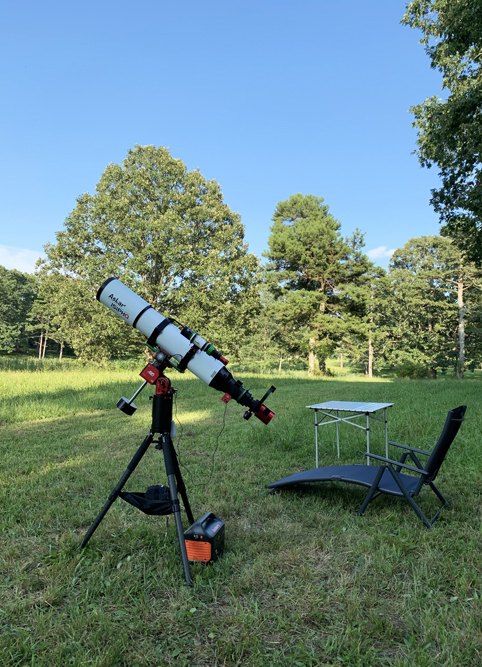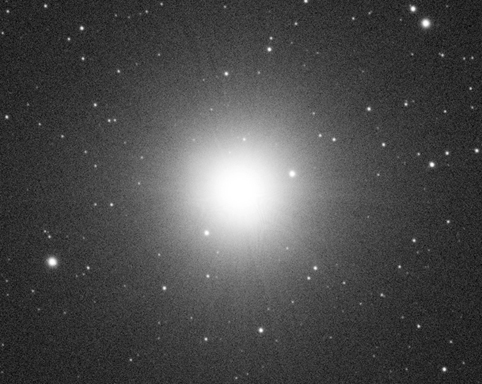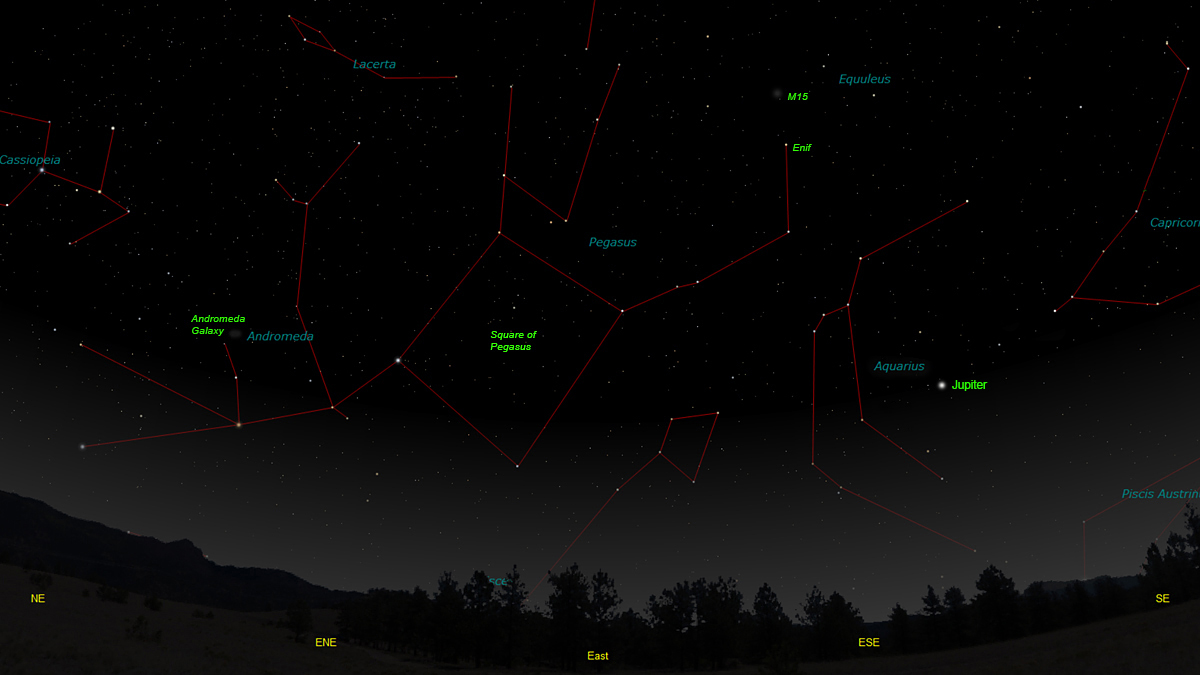The purpose of this feature is to give scout leaders, educators and naturalists an idea of some of the natural events coming up each month. We will try to cover a variety of natural events ranging from sky events to calling periods of amphibians, bird and mammal watching tips, prominent wildflowers and anything else that comes to mind. We will also note prominent constellations appearing over the eastern horizon at mid-evening each month for our area for those who would like to learn the constellations. If you have suggestions for other types of natural information you would like to see added to this calendar, let us know! Though we link book references to nationwide sources, we encourage you to support your local bookstore whenever possible.
Notes From July 2023 In early July, after working on a habitat survey on some beautiful property near Dandridge, Tennessee, we came home to weather that was more tropical than temperate. The rain was good for gardens but terrible for astrophotography. I had just taken delivery of a six-inch astrograph, and I needed to check it out to see if the optics were okay.
Next I wanted to take a long exposure image. The weather gods were kind and a mild cold front came through on July 24th. I took images on the nights of July 25th, 26th and 27th. My target was a small region of the Cygnus ionized hydrogen cloud call Simeis 57. It's about 4,600 light-years distant. The whole area, near the star Gamma Cygni, glows in the light of ionized hydrogen and oxygen. I chose this area because I had seen images of it that suggested the shape of an owl to me. It looked like a fun first image for the new scope. Everything worked remarkably well on the new setup. I already had the mounting and other imaging accessories like the camera and filter wheel. The counterweight is from another telescope. The image of Simeis 57 above is only 1/5th the size of the original image. To the naked eye, only the bright star in the top left corner of the image is visible. And that star can only be seen by someone with keen vision from a site far away from city lights. Everything else is much fainter. The "owl" as shown would span almost two full Moons if you could see it. The lounge chair in the image at right is one of the things I enjoy most about my astrophotography. After I polar align the scope, get the autoguiding started and enter my imaging plan into the scope's software, I sit down and relax.
I listen to the serenade from the
pond just a hundred feet away. Green Frogs plunk their loose banjo strings and growl at me.
Occasionally a Bullfrog gives his rumbling call. Green Treefrog and Gray
Treefrog calls drift up from the second pond a half mile distant.
The Katydid chorus starts slowly, then builds. I settle back and drift
into the night. Sky Events for August 2023: The Perseid Meteor Shower is predicted to peak at 7:58 UTC on August 13th. The early morning hours of August 13th and 14th should provide the best viewing. There will be a waning crescent Moon that will only be ten-percent illuminated, so it will not interfere a great deal.
Morning Sky: Jupiter rises just around 1:00am at the beginning of the month. Look for it in Aries low above the East-Southeast horizon. You will get better telescopic views by viewing it just before dawn. Evening Sky: Venus, Mars and Mercury are low in the western sky after sunset. Venus displays a beautiful tiny crescent in binoculars. It's fun to replicate Galileo's famous discovery in 1610! Try to be at your observing spot (preferably with a low western horizon) by sundown. Then scan above the horizon for several binocular widths looking due west. You may want to look up the magnetic declination from your location, so you can correct your compass heading for that. Several degrees can make a big difference in where you look for Venus. Find out how to correct for magnetic declination here. A handy calculator for magnetic declination, where you can just type in your street address, is here. If you spot Venus you can use an app like Sky Safari to see how much you need to offset from Venus to find the other two planets.
At the
beginning of the month Mercury will be above Venus, but it's
fainter and will take about 15 minutes longer to appear. On June 30th I
spotted Venus in binoculars about 12 minutes after official sunset. Mercury
appeared above and slightly to the left of Venus 15 minutes later.
Although Venus became visible to the naked eye a few minutes after I
spotted it in binoculars, I never did see Mercury with the naked eye. Mercury is at its greatest elongation from the Sun
on August 9th, and I wouldn't be surprised if it is visible to the naked
eye at that time. Mars continues to fade and drifts through Leo this month. Look for it above and to the left of Venus in the western sky at dusk. It will become harder to see as the month goes on due to the twilight glow. Mars will take its time fading from view however. It does not set with the Sun until November. An app like Sky Safari will make your search easier. At the beginning of the month look for Saturn in Aquarius, low in the Southeast in the early evening. On August 1st it will be to the left of the full Moon. The tilt of Saturn's rings is decreasing as our perspective of the rings changes as it orbits the Sun. The next time the rings will appear edge-on is March 2025.Constellations:
In Pegasus, the reddish star Enif marks the nose of the flying horse. Just above Enif is the globular cluster Messier 15, a nice ball of stars about 33,600 light-years away. The cluster was discovered by Jean Dominique Maraldi on September 7th, 1746. Maraldi was searching for De Chéseaux' Comet at the time. High overhead, in Hercules, another globular cluster is at its best this month. Messier 13 can sometimes be picked out with the naked eye on a dark moonless night. It is about 25,000 light-years distant. In a small telescope it will appear like a little cotton ball of faint light. With increasing aperture, you'll be able to spot some of the faint stars around the periphery of the cluster. Be sure to use averted vision, looking to one side of the cluster, to allow the cluster's light to fall on the light-sensitive rod cells of your eye.
On Learning the Constellations: Try to learn a few constellations each month, and then following them through the seasons. Once you associate a particular constellation coming over the eastern horizon at a certain time of year, you may start thinking about it like an old friend, looking forward to its arrival each season. The stars in the evening scene above, for instance, will always be in the same place relative to the horizon at the same time and date each August. Of course, the planets do move slowly through the constellations, but with practice you will learn to identify them from their appearance. In particular, learn the brightest stars for they will guide you to the fainter stars. Once you can locate the more prominent constellations, you can "branch out" to other constellations around them. It may take you a little while to get a sense of scale, to translate what you see on the computer screen or what you see on the page of a book to what you see in the sky. Look for patterns, like the stars that make up the "Square of Pegasus."
The earth's rotation causes the constellations to appear to
move across the sky just as the Sun and the Moon appear to do. If you go
outside earlier than the time shown on the charts, the constellations will be
lower to the eastern horizon. If you observe later, they will have climbed
higher. As each season progresses, the earth's motion around the Sun causes the constellations to appear a little farther towards the west each night for any given time of night. If you want to see where the constellations in the above figures will be on September 15th at 10:00pm CDT, you can stay up till midnight on August 15th and get a preview. The westward motion of the constellations is equivalent to two hours per month. Recommended: Sky & Telescope's Pocket Star Atlas is beautiful, compact star atlas. A good book to learn the constellations is Patterns in the Sky, by Hewitt-White. For sky watching tips, an inexpensive good guide is Secrets of Stargazing, by Becky Ramotowski.
A good general reference book on astronomy is the Peterson
Field Guide,
A Field Guide to the Stars and Planets, by Pasachoff. The book retails for around $14.00.
The Virtual Moon Atlas is a terrific way to learn the surface features of the Moon. And it's free software. You can download the Virtual Moon Atlas here. Apps: The Sky Safari 6 basic version is free and a great aid for the beginning stargazer. We really love the Sky Safari 6 Pro. Both are available for iOS and Android operating systems. There are three versions. The Pro is simply the best astronomy app we've ever seen. The description of the Pro version reads, "includes over 100 million stars, 3 million galaxies down to 18th magnitude, and 750,000 solar system objects; including every comet and asteroid ever discovered." A nother great app is the Photographer's Ephemeris. Great for finding sunrise, moonrise, sunset and moonset times and the precise place on the horizon that the event will occur. Invaluable not only for planning photographs, but also nice to plan an outing to watch the full moon rise. Available for both androids and iOS operating systems.Amphibians:
Recommended: The Frogs and Toads of North America, Lang Elliott, Houghton Mifflin Co. Archives (Remember to use the back button on your browser, NOT the back button on the web page!) Natural Calendar February 2023 Natural Calendar December 2022 Natural Calendar November 2022 Natural Calendar September 2022 Natural Calendar February 2022 Natural Calendar December 2021 Natural Calendar November 2021 Natural Calendar February 2021 Natural Calendar December 2020 Natural Calendar November 2020 Natural Calendar September 2020 Natural Calendar February 2020 Natural Calendar December 2019 Natural Calendar November 2019 Natural Calendar September 2019 Natural Calendar February 2019 Natural Calendar December 2018 Natural Calendar November 2018 Natural Calendar September 2018 Natural Calendar February 2018 Natural Calendar December 2017 Natural Calendar November 2017 Natural Calendar October 2017Natural Calendar September 2017 Natural Calendar February 2017 Natural Calendar December 2016 Natural Calendar November 2016 Natural Calendar September 2016Natural Calendar February 2016 Natural Calendar December 2015 Natural Calendar November 2015 Natural Calendar September 2015 Natural Calendar November 2014 Natural Calendar September 2014 Natural Calendar September 2013 Natural Calendar December 2012 Natural Calendar November 2012 Natural Calendar September 2012 Natural Calendar February 2012 Natural Calendar December 2011 Natural Calendar November 2011 Natural Calendar September 2011 Natural Calendar December 2010 Natural Calendar November 2010 Natural Calendar September 2010 Natural Calendar February 2010 Natural Calendar December 2009 Natural Calendar November 2009 Natural Calendar September 2009 Natural Calendar February 2009 Natural Calendar December 2008 Natural Calendar November 2008 Natural Calendar September 2008 Natural Calendar February 2008 Natural Calendar December 2007 Natural Calendar November 2007 Natural Calendar September 2007 Natural Calendar February 2007 Natural Calendar December 2006 Natural Calendar November 2006 Natural Calendar September 2006 Natural Calendar February 2006
Natural Calendar December 2005
Natural Calendar November 2005
Natural Calendar September 2005
Natural Calendar February 2005
Natural Calendar December 2004
Natural Calendar November 2004
Natural Calendar September 2004
Natural Calendar February 2004
Natural Calendar December 2003
Natural Calendar November 2003 Natural Calendar February 2003 Natural Calendar December 2002 Natural Calendar November 2002 Nature Notes Archives: Nature Notes was a page we published in 2001 and 2002 containing our observations about everything from the northern lights display of November 2001 to frog and salamander egg masses. Night scenes prepared with The Sky Professional from Software Bisque All images and recordings © 2023 Leaps
|
|






